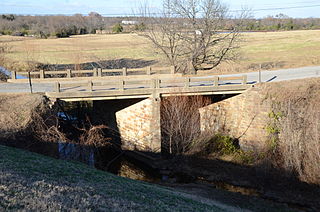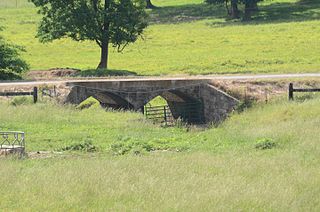
U.S. Route 64 is a U.S. route running from Teec Nos Pos, Arizona east to Nags Head, North Carolina. In the U.S. state of Arkansas, the route runs 246.35 miles (396.46 km) from the Oklahoma border in Fort Smith east to the Tennessee border in Memphis. The route passes through several cities and towns, including Fort Smith, Clarksville, Russellville, Conway, Searcy, and West Memphis. US 64 runs parallel to Interstate 40 (I-40) until Conway, when I-40 takes a more southerly route.

The Cove Creek Bridge is a historic bridge, carrying Arkansas Highway 309 across Cove Creek, south of the hamlet of Corley, Arkansas in the Ozark-St. Francis National Forest. It is a two-span closed-spandrel masonry arch structure, with each span measuring 13 feet (4.0 m) and an overall structure length of 26 feet (7.9 m). It is built entirely out of stone, with a concrete and asphalt deck, and concrete barriers at the sides. It was built in 1936 with funding support from the Works Progress Administration.

The 11th Street Bridge was completed in December 1915 to carry vehicles across the Arkansas River at Tulsa, Oklahoma. Used from 1916 to 1972, it was also a part of U.S. Route 66. Functionally, it has been replaced by the I-244 bridges across the Arkansas. As of 2009, the bridge was in poor structural condition and unsafe even for pedestrians. In 2008, the gates were locked to exclude all visitors.

The Old Benton—Sardis Road Bridge is a historic bridge off Arkansas Highway 183 in Bauxite, Arkansas. It is a concrete deck truss bridge, with a span of about 15 feet (4.6 m), and is oriented east–west along an old road bed, resting on concrete abutments with diagonal wing walls. The bridge was built in 1919 as part of a project to build a new road connecting Benton to Sardis, which would facilitate the transport of bauxite mined in the area. Unlike other concrete bridges built at that time, this bridge included fieldstone in its guardrails, which provided a decorative aspect as well as perhaps being inexpensive locally. The method of contracting and construction of the road and bridge, involving the establishment of a road improvement district, was an important advance in the means by which roads were built in Arkansas.

U.S. Route 71 is a U.S. route that runs from Krotz Springs, LA to the Fort Frances–International Falls International Bridge at the Canadian border. In Arkansas, the highway runs from the Louisiana state line near Doddridge to the Missouri state line near Bella Vista. In Texarkana, the highway runs along State Line Avenue with US 59 and partially runs in Texas. Other areas served by the highway include Fort Smith and Northwest Arkansas.

The Gilead Brook Bridge was an historic bridge which carried Vermont Route 12 across Gilead Brook north of the center of Bethel, Vermont. Built in 1928, it was one of four multi-span Warren deck truss bridges built in the state after extensive flooding in 1927. It was listed on the National Register of Historic Places in 1990. It was replaced in 2019-2020.

The Coop Creek Bridge is a historic bridge in Sebastian County, Arkansas, just outside the city of Mansfield. It carries Broadway, designated County Route 62, across Coop Creek just north of Mansfield Lake. It is a two-span open masonry structure, with one span of 18 feet (5.5 m) and one of 21 feet (6.4 m), with a total structure length of 44 feet (13 m). The bridge is set on masonry abutments and piers, with a reinforced concrete deck that is lined by simple concrete railings. It is a well-preserved example of a masonry bridge built in 1940.

The Goff Farm Stone Bridge is a historic bridge in eastern Fayetteville, Arkansas. It carries Goff Farm Road across an unnamed creek just north of Stonebridge Meadows Golf Club. The bridge is a single-span stone arch with a span of 20 feet (6.1 m) and a total bridge length of 150 feet (46 m). The bridge's builder is unknown, and its design suggests it was built circa 1860, when the road it carries was a major east–west thoroughfare connecting Fayetteville and Huntsville. It is believed to be the oldest masonry bridge in the state, and is one of the state's small number of surviving 19th-century stone bridges.

The Hackett Creek Bridge is a historic bridge near Hackett, Arkansas, which carries Arkansas Highway 45 across Hackett Creek. The bridge is a three-span concrete structure set on abutments and piers of stone and concrete. The longest single span is 36 feet (11 m) long, and the total bridge length is 98 feet (30 m). The deck is asphalt laid over concrete, and there are simple concrete railings on either side. Built in 1941, it is a well-preserved concrete bridge of the period.

The Milltown Bridge is a historic stone arch bridge in rural southeastern Sebastian County, Arkansas. The bridge carries County Road 77 across an unnamed brook just west of its junction with White Mountain Road. It is a two-span closed spandrel structure, with each arch spanning 10 feet (3.0 m) and a total length of 24 feet (7.3 m). The arches are formed out of rough-cut stone voussoirs. It was built in the 1930s with funding from the Works Progress Administration, and was, when listed on the National Register of Historic Places in 1990, one of only eight documented bridges of its type in the state. The bridge was delisted from the register in 2002.

The Mountain Fork Bridge is a historic bridge in rural Polk County, Arkansas. It carries County Road 38 across Mountain Fork River north of Hatfield and southwest of Mena. The bridge consists of two spans of steel Pratt pony trusses, with a total length of 406 feet (124 m), including approach spans. The trusses are set on piers consisting of steel rings filled with concrete; each of these spans is 80 feet (24 m) long. The bridge's construction date and builder are unknown; it predates the standardization of bridge designs in the state in 1923. It is estimated to date to the early 1900s.

The Newport Bridge is a historic cantilevered Warren truss bridge over the White River in Newport, Arkansas. Built in 1930 to carry U.S. Route 67 (US 67), the road it carries is now designated Arkansas Highway 367 (AR 367) after the former highway was relocated. The main bridge is 400 feet (120 m) long, with approaches from the west of 1,278 feet (390 m) and the south of 911 feet (278 m). It has cantilevered arms 138 feet (42 m) long supported by concrete piers, with a suspended Warren truss span of 125 feet (38 m). Designed by Ira G. Hedrick, it is one of three such bridges in the state.

The Cedar Creek Bridge is a historic bridge in rural southern Independence County, Arkansas. It is located on Goodie Creek Road, about 1.5 miles (2.4 km) south of its junction with Arkansas Highway 14. It is a two-span stone masonry structure, spanning Cedar Creek, a tributary to the White River, with two closed-spandrel arches having a total length of 30 feet (9.1 m). Its deck is 24.1 feet (7.3 m) wide, with a total structure width of 26.1 feet (8.0 m), including the parapets at the sides. The bridge was built 1941, and was probably designed by an engineer of the state's highway department.

The Little Buffalo River Bridge is a historic bridge in central Newton County, Arkansas. The bridge carries Arkansas Highway 327 across the Little Buffalo River between Parthenon and Jasper. It is a seven-span reinforced concrete T-beam structure, with a total length of 212 feet (65 m) and a longest single span of 30 feet (9.1 m). It has a curb width of 19.1 feet (5.8 m), and an overall width of 22.3 feet (6.8 m), including the concrete balustrades on each side. It was built in 1939.

The South Fork Bridge is a historic bridge spanning the South Fork Saline River in Fountain Lake, Arkansas. It formerly carried Arkansas Highway 128, whose modern bridge now stands just to the south, a short way east of its junction with Arkansas Highway 5. It is a two-span concrete closed-spandrel arch structure, with spans of 57 feet (17 m) and a roadway width of 16 feet (4.9 m). It was built in 1928 by a county crew, after major flooding in 1927 damaged road infrastructure in the area.

The West James Street Overpass is a historic bridge in Redfield, Arkansas. It carries West James Street across the Union Pacific railroad tracks near the center of the community.

The Colburn Bridge is a historic bridge in Pittsford, Vermont. It is a masonry arch bridge, carrying U.S. Route 7 (US 7) across Sugar Hollow Brook a short way east of the town center. Built in 1899, it is one of a modest number of surviving masonry arch bridges in the state, and exhibits particularly high quality period workmanship. It was listed on the National Register of Historic Places in 1990.

The Van Buren County Road 2E Bridge is a historic bridge in rural southwestern Van Buren County, Arkansas. It is a three-span open concrete masonry structure, with each span measuring 12 feet (3.7 m) in length, carrying County Road 2E across an unnamed tributary of Driver's Creek. The bridge rests on piers and abutments of stone and concrete, and has a roadway deck 19.9 feet (6.1 m) wide. It was built in 1940 with funding from the Works Progress Administration, and is a well-preserved example of a period concrete bridge.
The Petit Jean River Bridge is a historic bridge in rural southern Logan County, Arkansas. The bridge carries Old Highway 109 across the Petit Jean River between Sugar Grove and Magazine. It consists of a single-span steel Pratt through truss and two masonry approach spans, set on concrete piers in the river. The total structure length is 273 feet (83 m), with a roadway width of 19 feet (5.8 m) and a total width of 24 feet (7.3 m). The bridge was built in 1938.

The West Sixth Street Bridge is a historic stone arch bridge in downtown Austin, Texas. Built in 1887, the bridge is one of the state's oldest masonry arch bridges. It is located at the site of the first bridge in Austin, carrying Sixth Street across Shoal Creek to link the western and central parts of the old city. The bridge was added to the National Register of Historic Places in 2014.






















